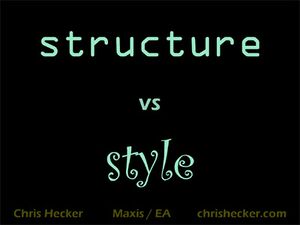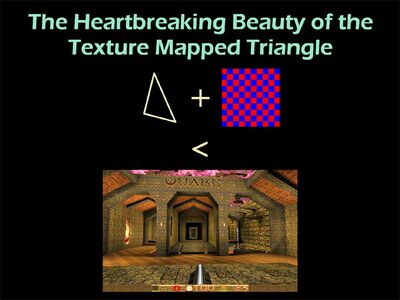 My 2008 Game Developers Conference lecture was titled Structure vs. Style, wherein I analyzed how we solve what I call "hard interactive problems". This lecture became mildly famous in game Artificial Intelligence circles because in it I posit we will eventually have a Photoshop of AI, whatever that means! The lecture talks about the characteristics I think a tool like this will need to possess to be worthy of the name, but it's very hard to know what it really means, or how to get there. In fact, there's a panel at the 2009 AI Summit at GDC debating this topic, The Photoshop of AI: Debating the Structure vs Style Decomposition of Game AI.
My 2008 Game Developers Conference lecture was titled Structure vs. Style, wherein I analyzed how we solve what I call "hard interactive problems". This lecture became mildly famous in game Artificial Intelligence circles because in it I posit we will eventually have a Photoshop of AI, whatever that means! The lecture talks about the characteristics I think a tool like this will need to possess to be worthy of the name, but it's very hard to know what it really means, or how to get there. In fact, there's a panel at the 2009 AI Summit at GDC debating this topic, The Photoshop of AI: Debating the Structure vs Style Decomposition of Game AI.
The thrust of this lecture is my claim that any solution to a "hard interactive problem" will have a structure vs. style decomposition. I define "hard interactive problems" as problems at the intersection of technology, aesthetics, and interactivity. The canonical example of a structure/style decomposition is the texture mapped triangle. I claim the texture mapped triangle is the technology that has had the single greatest impact on games in our history, for better or for worse. I think texture mapped triangles are so effective because they are described by both a very elegant and powerful structure (x, y, z coordinates, u, v texture coordinates, connectivity, texels), and an incredibly rich and deep style (the coordinates of the vertices, the colors in the texture). The computer can reason about the triangles' structure—drawing, hittesting, traversing—while artists can work on the style of the triangles—creating moods and atmosphere.

Other examples of great structure vs. style decompositions include wavetable synthesis, mesh skinning, motion capture processing, html+css, and typefaces. The Spore creature animation system has an explicit structure vs. style decomposition at work as well, as does the creature paint, which I'll write about in the future.
I'll write more about these topics here at some point. This work grew out of my original interest in sampling vs. synthesis as approaches to solving problems, and I think there's a lot of good stuff to mine in this area for problem solving for games.
The materials:
- The slides.
- The audio.



